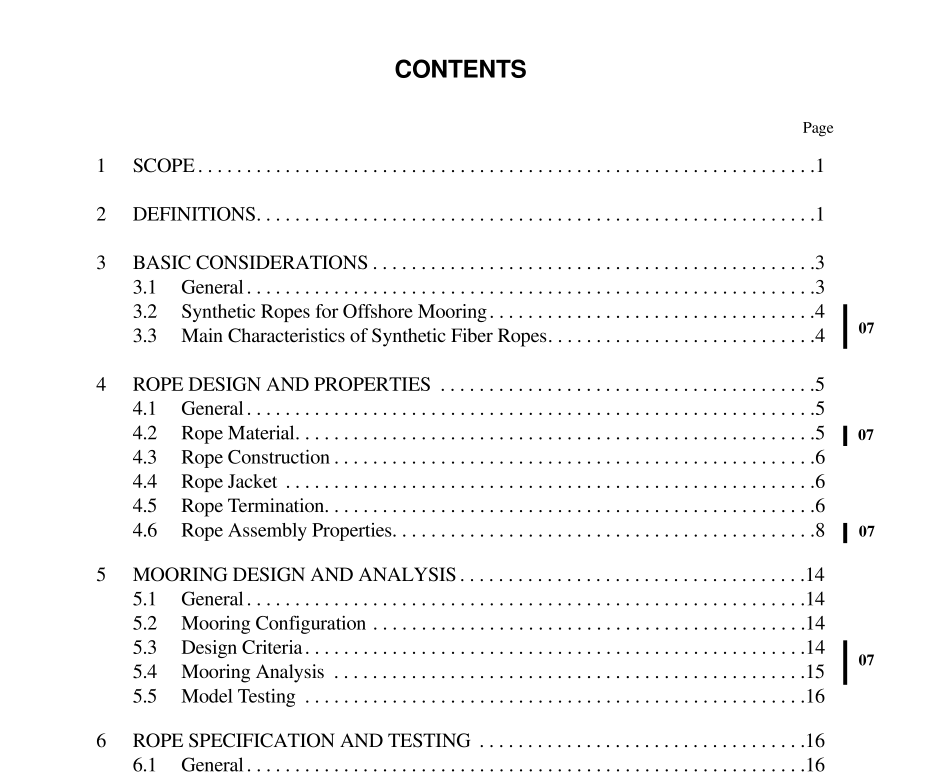API RP 2SM pdf download

API RP 2SM pdf download.Design, Manufacture, Installation, and Maintenance of Synthetic Fiber Ropes for Offshore Mooring
1 Scope
The main purpose of this document is to provide guidelines on the use of synthetic fiber ropes for offshore mooring appli- cations. The secondary purpose of this document is to high- light differences between synthetic rope and traditional steel mooring systems, and to provide practical guidance on how to handle these differences during system design and installa- tion. Since synthetic fiber rope properties will influence the mooring system performance, mooring design and analysis; rope design, testing and manufacturing; rope handling and installation; and rope inspection and maintenance should be integrated to provide a consistent mooring system design methodology. Thus this document covers primarily the fol- lowing aspects: a. Design and analysis considerations of mooring system. b. Design criteria for mooring components. c. Rope design. d. Rope specification and testing. e. Rope manufacture and quality assurance. f. Rope handling and installation. g. In-service inspection and maintenance. The contents of this document should be read in conjunc- tion with API RP 2SK, Design and Analysis of Stationkeeping Systems for Floating Structures , Second Edition, December 1996 [1]. Where the mooring design, construction and installa- tion details are similar or equivalent to steel wire/chain moor- ing systems, no further comments are included in this document.The production of this document reflects the potential growth in offshore mooring applications for synthetic fiber ropes and the need for a consolidated written guidance. At this time the design, analysis, manufacture, testing and instal- lation procedures vary, and there is limited in-situ experience with synthetic rope moorings. Thus where committee mem- bers have reached consensus, more specific recommenda- tions are provided in the document. Specifically, those items for which the committee members have reached consensus as being recommended or essential for an adequate mooring system are identified in the text in conjunction with the word “should”. In other areas, general guidance is included in the document as general statements and/or commentary notes. The technology in synthetic fiber rope moorings is growing rapidly. Designers are advised to take appropriate measures to ensure that their practices incorporate all research advances available to them. A technical commentary, which provides a detailed discussion on deepwater polyester rope mooring technology, has recently been made available through the DeepStar Joint Industry Project [31]. This document applies to synthetic fiber ropes used in the form of taut leg or catenary moorings for both permanent and temporary offshore installations such as: a. Monohull based FPSOs. b. Semi-submersible based FPUs. c. Mobile Offshore Drilling Units (MODU). d. SPAR Buoy platforms. e. CALM Buoy (spread mooring only). This document is not intended to cover other marine appli- cations of synthetic fiber ropes such as tanker mooring at piers and harbours, towing hawsers, mooring hawsers at SPMs, and TLP tethers. Additionally, very little test data is available for large synthetic fiber ropes permanently deployed around fairleads and thus this document is limited to fiber ropes which span freely between end terminations. The fiber materials covered in this document include poly- ester, , HMPE and nylon; and the rope structures include “wire- rope-construction” and “parallel-strand” types. Other fiber materials and rope structures may be used, but the recommen- dations given must be re-evaluated with considerations of the properties and performance of these materials and construc- tions. Furthermore, the document has been primarily devel- oped based on the test data and knowledge on polyester ropes. Designers are advised to consult rope manufacturers when other types of ropes are considered. As more experience is gained from relevant applications, this recommended practice will be subject to additions, com- ments and revisions. These and continued research and devel- opment efforts in this area will be considered in future editions of this recommended practice.









